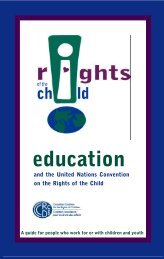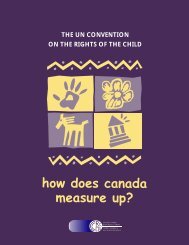CCRC report on rights of children in Canada - Canadian Coalition ...
CCRC report on rights of children in Canada - Canadian Coalition ...
CCRC report on rights of children in Canada - Canadian Coalition ...
You also want an ePaper? Increase the reach of your titles
YUMPU automatically turns print PDFs into web optimized ePapers that Google loves.
child welfare called for a major overhaul <strong>of</strong> child welfare <strong>in</strong> <strong>Canada</strong> to reflect C<strong>on</strong>venti<strong>on</strong> pr<strong>in</strong>ciples. Of<br />
primary c<strong>on</strong>cern are two tendencies with<strong>in</strong> prov<strong>in</strong>cial/territorial child welfare practice: (a) <strong>children</strong> are<br />
still treated as objects <strong>of</strong> protecti<strong>on</strong> and pity rather than <strong>rights</strong>-holders who need support to exercise<br />
their <strong>rights</strong>; and (b) a family-centered approach is used rather than a child-centered approach with<strong>in</strong><br />
a family c<strong>on</strong>text. The implicati<strong>on</strong>s <strong>of</strong> the C<strong>on</strong>venti<strong>on</strong> for child protecti<strong>on</strong> laws, policies, and practices<br />
need more attenti<strong>on</strong> across the country.<br />
In 2010 the Nati<strong>on</strong>al Youth <strong>in</strong> Care Network facilitated a nati<strong>on</strong>-wide process to give young people and<br />
alumni from child welfare care an opportunity to discuss their needs and views. 64 More than 280 young<br />
people participated at the prov<strong>in</strong>cial and nati<strong>on</strong>al level. A full descripti<strong>on</strong> <strong>of</strong> the c<strong>on</strong>sultati<strong>on</strong> process<br />
and detailed f<strong>in</strong>d<strong>in</strong>g are available <strong>in</strong> the f<strong>in</strong>al <str<strong>on</strong>g>report</str<strong>on</strong>g> <strong>on</strong> the <str<strong>on</strong>g>CCRC</str<strong>on</strong>g> website. 65 Follow<strong>in</strong>g is a summary <strong>of</strong><br />
the key issues and recommendati<strong>on</strong>s identified through this process and c<strong>on</strong>tributi<strong>on</strong>s from others<br />
<strong>in</strong>volved <strong>in</strong> child welfare across the country.<br />
Equitable Treatment<br />
Young people <strong>in</strong> care identified the experience <strong>of</strong> be<strong>in</strong>g treated differently from others as a major<br />
c<strong>on</strong>cern. They shared daily experiences <strong>of</strong> be<strong>in</strong>g treated differently because they were <strong>in</strong> the child<br />
welfare system. They spoke about be<strong>in</strong>g s<strong>in</strong>gled out at school by teachers and be<strong>in</strong>g excluded from<br />
school activities because <strong>of</strong> their status. They shared examples <strong>of</strong> be<strong>in</strong>g assessed <strong>on</strong> the basis <strong>of</strong> risks<br />
rather than <strong>on</strong> what they could c<strong>on</strong>tribute. Others shared the embarrassment they experience when<br />
family members are required to complete crim<strong>in</strong>al record checks to meet with them or when they are<br />
required to ask their employer for a letter verify<strong>in</strong>g their hours <strong>of</strong> work. Social stigma and the negative<br />
image <strong>of</strong> child welfare make it difficult to fit <strong>in</strong> the community and f<strong>in</strong>d friends.<br />
The experiences <strong>of</strong> young people reveal <strong>in</strong>c<strong>on</strong>sistencies <strong>in</strong> laws and agency policies, as well as<br />
different <strong>in</strong>terpretati<strong>on</strong>s <strong>of</strong> the rules by pers<strong>on</strong>s <strong>in</strong> authority. These lead to <strong>in</strong>equitable treatment<br />
between youth <strong>in</strong> care and between youth <strong>in</strong> care and other people <strong>of</strong> similar age. At a systemic level,<br />
c<strong>on</strong>cerns about equitable treatment arise from the follow<strong>in</strong>g factors: different maximum ages for<br />
protecti<strong>on</strong> <strong>in</strong>terventi<strong>on</strong>, different grounds for protecti<strong>on</strong> services, different levels <strong>of</strong> child participati<strong>on</strong><br />
with<strong>in</strong> the court processes and adm<strong>in</strong>istrative decisi<strong>on</strong>-mak<strong>in</strong>g processes for <strong>children</strong> who may need<br />
protecti<strong>on</strong>, marked deviati<strong>on</strong>s <strong>in</strong> child protecti<strong>on</strong> caseloads, and different levels <strong>of</strong> budgetary allocati<strong>on</strong><br />
to child protecti<strong>on</strong> services.<br />
Internati<strong>on</strong>al Guidel<strong>in</strong>es for the Alternative Care <strong>of</strong> Children, based <strong>on</strong> the C<strong>on</strong>venti<strong>on</strong> <strong>on</strong> the Rights<br />
<strong>of</strong> the Child, were adopted <strong>in</strong> 2009. 66 In 2011 the UN Committee <strong>on</strong> the Rights <strong>of</strong> the Child adopted<br />
General Comment 13 <strong>on</strong> the right <strong>of</strong> a child to be free from all forms <strong>of</strong> violence. This <strong>in</strong>terpretive guide<br />
to article 19 <strong>of</strong> the C<strong>on</strong>venti<strong>on</strong> addresses all aspects <strong>of</strong> child protecti<strong>on</strong>. 67 There has been no evaluati<strong>on</strong><br />
<strong>of</strong> how the different prov<strong>in</strong>cial/territorial laws and programs comply with these guidel<strong>in</strong>es, which cover<br />
what prov<strong>in</strong>ces call substitute care (e.g. foster homes, group homes) and alternative care (e.g. k<strong>in</strong>ship<br />
care). Us<strong>in</strong>g <strong>in</strong>ternati<strong>on</strong>al guidel<strong>in</strong>es across all prov<strong>in</strong>ces to review and strengthen exist<strong>in</strong>g systems<br />
could help to ensure equitable treatment <strong>of</strong> all <strong>children</strong>, with flexibility <strong>in</strong> specific programm<strong>in</strong>g to<br />
resp<strong>on</strong>d to the variety <strong>of</strong> needs across the country.<br />
Aborig<strong>in</strong>al Youth <strong>in</strong> Care<br />
One high priority is the documented disparity <strong>in</strong> fund<strong>in</strong>g for Aborig<strong>in</strong>al child welfare services, compared<br />
to services provided to n<strong>on</strong>-Aborig<strong>in</strong>al <strong>children</strong> <strong>in</strong> similar circumstances. The issue <strong>of</strong> <strong>in</strong>equitable<br />
fund<strong>in</strong>g for preventive and early <strong>in</strong>terventi<strong>on</strong> assistance for Aborig<strong>in</strong>al <strong>children</strong>, documented by<br />
the Auditor General <strong>in</strong> 2008, has not been resolved. The <strong>Canadian</strong> Human Rights Tribunal recently<br />
dismissed a compla<strong>in</strong>t <strong>on</strong> the grounds that a comparis<strong>on</strong> cannot be made between federal and<br />
prov<strong>in</strong>cial services under <strong>Canada</strong>’s Human Rights Act. Under the C<strong>on</strong>venti<strong>on</strong>, however, <strong>Canada</strong> has<br />
made a commitment to equitable treatment <strong>of</strong> all <strong>children</strong>.<br />
Aborig<strong>in</strong>al youth <strong>in</strong> care <str<strong>on</strong>g>report</str<strong>on</strong>g>ed additi<strong>on</strong>al challenges they faced while <strong>in</strong> care. They stated that<br />
be<strong>in</strong>g placed <strong>in</strong>to care and frequent placement moves <strong>in</strong> care separates young people from their<br />
immediate families and extended family and friends, as well as their cultural heritage and traditi<strong>on</strong>s.<br />
Many Aborig<strong>in</strong>al youth <strong>in</strong> care <str<strong>on</strong>g>report</str<strong>on</strong>g> feel<strong>in</strong>g disc<strong>on</strong>nected from their culture, which makes it difficult to<br />
develop their own identity.<br />
Immigrant Children and Youth <strong>in</strong> Need <strong>of</strong> Protecti<strong>on</strong><br />
Young people who came to <strong>Canada</strong> and then found themselves <strong>in</strong> need <strong>of</strong> child protecti<strong>on</strong> spoke about<br />
direct and <strong>in</strong>direct discrim<strong>in</strong>ati<strong>on</strong> they experienced <strong>in</strong> new communities, <strong>in</strong>clud<strong>in</strong>g school systems and<br />
care placements. Some stated they had been placed <strong>in</strong>to homes with little or no understand<strong>in</strong>g <strong>of</strong> their<br />
culture, c<strong>on</strong>trary to C<strong>on</strong>venti<strong>on</strong> article 20(3), which requires that “due regard” be paid to “the child’s<br />
ethnic, religious, cultural, and l<strong>in</strong>guistic background” <strong>in</strong> alternative care placements. Some <str<strong>on</strong>g>report</str<strong>on</strong>g>ed<br />
that they entered care with a str<strong>on</strong>g sense <strong>of</strong> their cultural heritage and left it feel<strong>in</strong>g disc<strong>on</strong>nected and<br />
without a clear sense <strong>of</strong> their identity.<br />
Some shared that they left the care system without clear legal status, because caregivers and social<br />
workers did not pursue it <strong>on</strong> their behalf. This results <strong>in</strong> limited access to services after they leave the<br />
system.<br />
Know<strong>in</strong>g and Exercis<strong>in</strong>g Rights with<strong>in</strong> Child Welfare Systems<br />
Young people <strong>in</strong> care <strong>in</strong>dicated that <strong>of</strong>ten they are not <strong>in</strong>formed about their <strong>rights</strong>, the opti<strong>on</strong>s available<br />
to them for support or protecti<strong>on</strong> <strong>of</strong> their <strong>rights</strong>, and ways they can have a voice <strong>in</strong> decisi<strong>on</strong>s that affect<br />
them. Youth <str<strong>on</strong>g>report</str<strong>on</strong>g>ed that decisi<strong>on</strong>s are generally made for them and not with them, sometimes with<br />
no explanati<strong>on</strong>. Young people want their caregivers and social workers to ask for their views <strong>on</strong> opti<strong>on</strong>s<br />
for their care, to be transparent with them about why decisi<strong>on</strong>s are made, and to facilitate access to<br />
appeal processes <strong>of</strong> decisi<strong>on</strong>s made for them. This <strong>in</strong>cludes participati<strong>on</strong> <strong>in</strong> plans <strong>of</strong> care, placement<br />
opti<strong>on</strong>s, family reunificati<strong>on</strong>, or c<strong>on</strong>t<strong>in</strong>ued c<strong>on</strong>tact with biological or adoptive family members when<br />
possible. To implement the C<strong>on</strong>venti<strong>on</strong>, these <strong>rights</strong> should be legislated as a mandatory standard for<br />
all child welfare agencies and services <strong>in</strong>tended for young people <strong>in</strong> care.<br />
66 Right <strong>in</strong> pr<strong>in</strong>ciple, right <strong>in</strong> practice Pay<strong>in</strong>g Attenti<strong>on</strong> to Vulnerable Children 67




